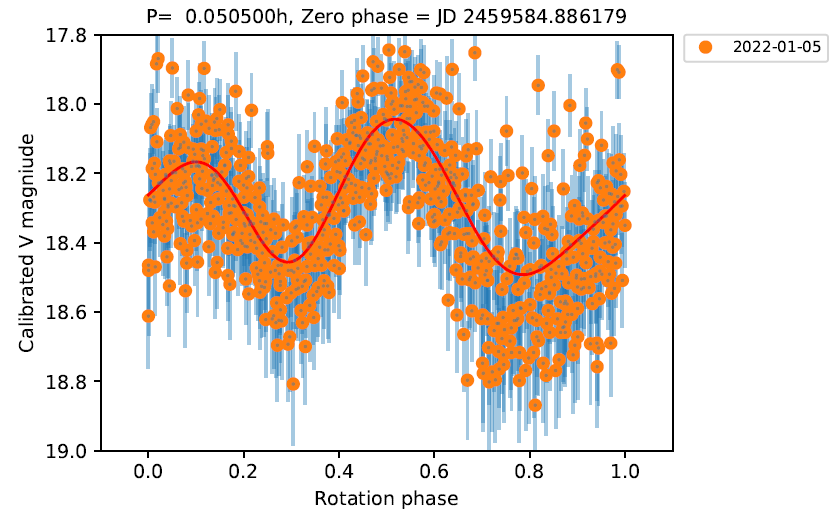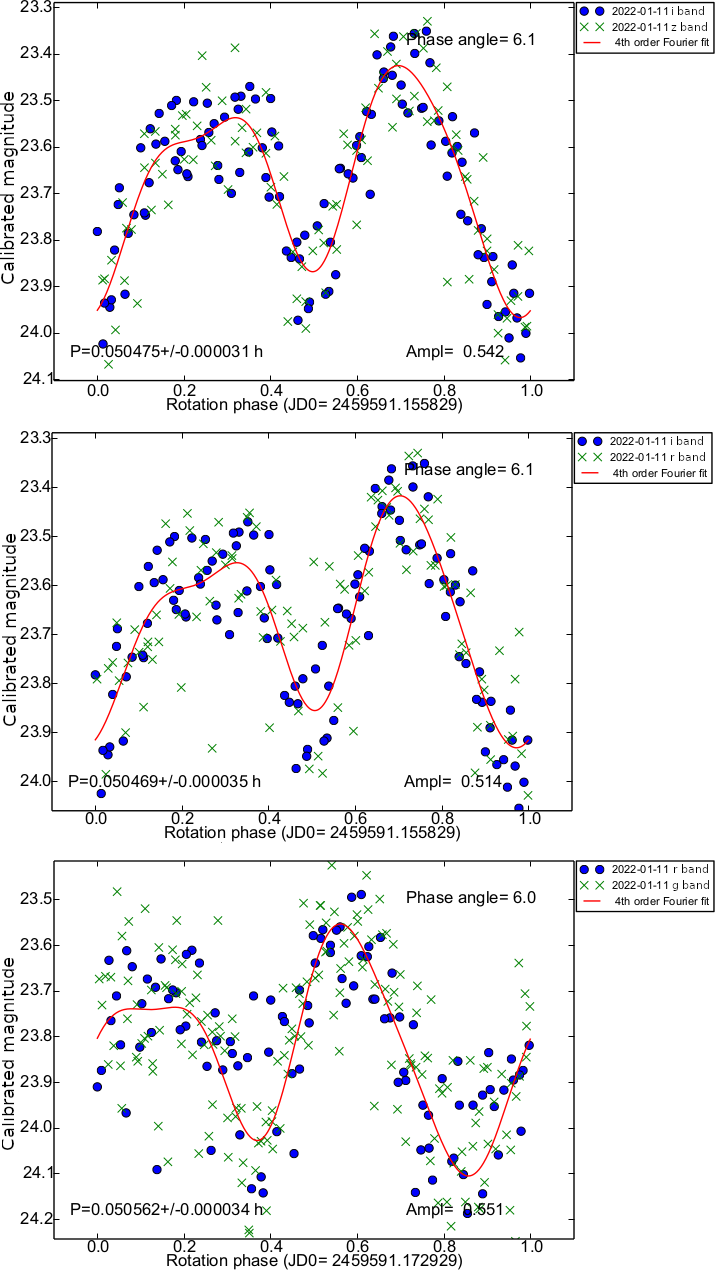Colours and taxonomy of 2022 AB: a super fast rotating near-Earth asteroid
- 1Astronomical Observatory Institute, Faculty of Physics, A. Mickiewicz University, Słoneczna 36, 60-286 Poznań, Poland
- 2IMCCE, Observatoire de Paris, PSL Research University, CNRS UMR 8028, 77 Av. Denfert-Rochereau, F-75014 Paris Cedex, France
- 3Institut de Recherche en Astrophysique et Planetologie, Toulouse, France
- 4National Youth Space Center, Goheung, Jeollanam-do, 59567, Korea
- 5Astronomical Institute of the Romanian Academy, 5 - Cutitul de Argint Street, 040557 Bucharest, Romania
Introduction
2022 AB is a very small near-Earth asteroid that passed Earth at a distance of 9.6 lunar distances on 20 January.
Our campaign started on 4 January and until 26 January, we observed 2022 AB using telescopes located in many places around the world. More about the campaign, including the determination of the phase curve, will be presented during this conference in a separate presentation [2]. Here we only present results regarding the colour indices, taxonomic class, and diameter. We organised a similar observation campaign for 2021 DW1 in 2021 [3][4][5].
Rotation period
In determining the colours indices, it is very important to know the rotation period of the asteroid. We discussed the issues, especially in the field of NEAs, at the conference last year [5].
We briefly discuss the determination of the rotation period using an example of observations from the first night of the campaign of 2022 AB. More will be discussed in [2].
We used a 0.7-m RBT/PST2 telescope(Arizona), 5-s exposures, and the clear filter. We observed object for 1.5 hours and we create composite lightcurve with Fourier series fit (see Figure 1). In this way, we determined the rotation period P=182 s.

Figure 1: Example of composite lightcurve of 2022 AB.
Colour indices
The preliminary results presented here are based on most of the data obtained. The full results will be presented during the conference.
To determine the colour indices, we used observations from three telescopes: 0.7-m RBT, 1-m telescope of DOAO (South Korea), and 1-m telescope of Pic du Midi Observatory (France). Telescopes from DOAO and Pic du Midi observed the asteroid with an exposure time of several seconds in the B,V,R,I (DOAO) or g’,r’,i’,z’ (Pic du Midi) filters. Due to changes in the geometry of the observations, we divided the observations into several sets. Using solar analogues, we transformed the brightness in B,V,R,I into g’,r’,i’,z’ bands, respectively. Then, knowing the rotation period, we composited the lightcurves to determine the shifts between the lightcurves in the given bands. We have prepared the composited lightcurves separately for each set. An example is shown in Figure 2. RBT observations were made in B,V,R filters and, as we mentioned, transformed them into g’,r’,i’. In this case, we used knowledge of the rotation period to average the brightness measurements over the period, exposure time Texp=P=182s. Adjacent measurements in different bands allowed us to determine a series of colour indices that we averaged as one set. The results for each set are shown in Table 1.

Figure 2: Composite lightcurves for DOAO set 1. Top: lightcurves in i’ (dots) and z’ band (crosses), middle: i’ and (dots) and r’ (crosses) bands, bottom: r’ (dots) and g’ (cross) bands.
Table 1: Preliminary results of colour indices for each set.
Taxonomy
To determine the taxonomic class of 2022 AB, we converted the average value of colour indices to the reflection coefficients Rr,Ri and Rz, normalised to the reflection values in the g band, using the formula [6]:
Rf=10−0.4[(f−g)−(f☉−g☉)]
Next, we compared them with spectra of different taxonomic classes, as given by [6]. In Figure 3 we present the reflective value of the asteroid compared to similar taxonomic classes. B class asteroids are rare and they are mainly associated with the outer main belt. 2022 AB as an NEA is an unlikely class B asteroid. The Cb class fits well with the data of 2022 AB and is the only one to show the common with 2022 AB characteristic of visible absorption around 0.6 micrometre. We suggest that 2022 AB is most likely a type Cb asteroid.
Figure 3: Plot of reflectivities values of B,Cb,Ch asteroid classes (black dots) and 2022 AB (red dots). Data for the B,Cb, and Ch classes were taken from [6].
Diameter
We can determine the diameter knowing the absolute magnitude H and the albedo pV according to equation [7]:
Deff=1329×10−H/5×pV−0.5
At the conference, we will present the results based on the determined H from the phase curve, but for now we used the approximate H=23.6±0.36 given by JPL[1]. Albedo for Cb class asteroids: pV=0.059±0.027 [8], hence Deff=0.104±0.029 km.
Figure 4: Rotation period-diameter plot. The red dotted line is the spin barrier (2.2 h). Other asteroid data come from LCDB [8].
Acknowledgements
This research was funded in whole or in part by the National Science Centre, Poland, grant No. 2021/41/N/ST9/04259.
References
[1] https://ssd.jpl.nasa.gov
[2] Kwiatkowski et al. (2022) Photometry and model of near-Earth asteroid 2022 AB from one apparition,EPSC 2022, held 18–23 September 2022 in Granada, Spain
[3] Kwiatkowski et al. (2021) A&A 656, A126
[4] Kwiatkowski et al. (2021) Photometry and model of near-Earth asteroid 2021 DW1 from one apparition, EPSC 2021, held virtually, 13-24 September 2021
[5] Koleńczuk et al. (2021) Determination of colour indices of super-fast rotator near-Earth asteroids, EPSC 2021, held virtually, 13-24 September 2021
[6] DeMeo & Carry (2013), Icarus 226, 723
[7] Fowler and Chillemi (1992) Phillips Laboratory, Hanscom AF Base, MA, 17–43
[8] Warner et al. (2009) Icarus 202, 134
How to cite: Koleńczuk, P., Kwiatkowski, T., Kamińska, M., Kamiński, K., Colas, F., Klotz, A., Kim, T., and Birlan, M.: Colours and taxonomy of 2022 AB: a super fast rotating near-Earth asteroid, Europlanet Science Congress 2022, Granada, Spain, 18–23 Sep 2022, EPSC2022-1161, https://doi.org/10.5194/epsc2022-1161, 2022.

